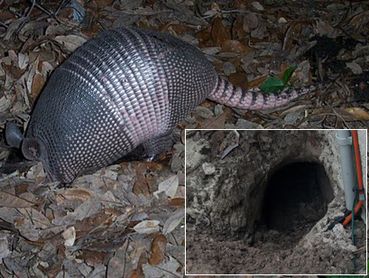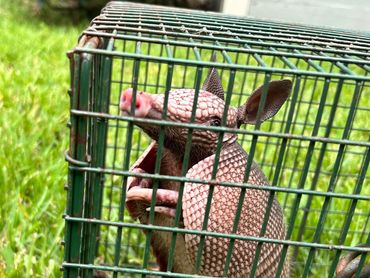Connect with Our Wildlife Experts Today! (904) 999-9241

Armadillo Removal & Prevention
Armadillos are nocturnal mammals known for their distinctive armor-like shell. Common in Northeast Florida, these creatures are often found digging in yards & gardens as they search for insects & grubs, their primary food sources.
Understanding & Preventing Armadillo Damage
Protect your Home & Property from Armadillo damage with Expert solutions. Our Comprehensive Armadillo Management services include Identification, Trapping, & Prevention Strategies tailored to your needs. Learn how to Safeguard your Home & Prevent future infestations with our Humane Methods.
Signs of Armadillo Activity:
- Burrowing: Armadillos are prolific diggers & create extensive burrow systems. Look for large burrows (approximately 7-10 inches in diameter) near structures, trees, or in open areas of your yard. These burrows can be 15-20 ft deep! Armadillos are known to have 3-4 burrows each.
- Holes: Armadillos dig small holes, about (3-5) inches wide & (1-3) inches deep, in search of insects & grubs. These holes are typically found in lawns, gardens, & flower beds & can be scattered throughout the area.
- Disturbed Soil & Mulch: Areas with disturbed soil or mulch can be a sign of armadillo activity. Armadillos often dig up flower beds, vegetable gardens, & other landscaped areas while foraging for food.
- Tracks & Prints: Armadillo tracks can sometimes be seen in soft soil or mud. They have four toes on their front feet & five toes on their back feet, with visible claw marks due to their strong digging claws.
- Nesting Sites: Armadillos may use dense vegetation, brush piles, or under decks & porches as nesting sites. Check these areas for signs of digging or burrowing. Did you know, Armadillos have 4 offspring every time they reproduce, its either 4-males or 4-females.
- Damage to Lawn & Plants: The extensive digging & burrowing by armadillos can cause significant damage to lawns, uproot plants, & disrupt root systems, leading to the deterioration of landscaped areas.
Other Indicators:
- Noises: Armadillos are generally quiet, but you might hear rustling in the evening or early morning as they forage for food or maybe you hear their armored back scraping alongside ur home.
- Droppings: Although less common, you might find armadillo droppings in areas where they are active. These are usually medium, pellet-like, & a bad odor.
Why Do Armadillos Dig in My Yard?
Why Do Armadillos Dig in My Yard?
Why Do Armadillos Dig in My Yard?

Armadillos dig in your yard primarily to search for food. These nocturnal creatures have a keen sense of smell, allowing them to detect insects, grubs, & worms beneath the soil. Their powerful claws enable them to dig efficiently, creating burrows & foraging pits as they hunt for their next meal. If you notice these holes on your lawn, it's likely due to armadillos searching for these underground food sources. Understanding their behavior can help in implementing effective armadillo control measures.
Potential Damage Caused
Why Do Armadillos Dig in My Yard?
Why Do Armadillos Dig in My Yard?

Armadillos can cause significant damage to your yard & property. Their digging habits lead to unsightly holes & uprooted plants, disrupting your landscaping efforts. These burrows can also undermine the stability of walkways, driveways, & foundations, posing potential safety hazards. Additionally, armadillos may dig under decks, patios, & other structures, causing further structural damage. Protect your property from armadillos with expert removal & prevention services.
Identifying Armadillo Damage






Preventive Measures:
By recognizing these signs, you can identify an armadillo infestation early & take appropriate steps to address the problem. For effective & humane removal, it’s always best to contact a professional wildlife management company.
- Maintain Your Yard: Regularly mow your lawn, trim bushes, & remove brush piles to reduce potential nesting sites.
- Reduce Food Sources: Treat your lawn for insects & grubs to make it less attractive to foraging armadillos but use caution because grubs make a healthy fertilizer.
- Physical Barriers: Install fences or barriers around gardens & other sensitive areas to prevent armadillos from digging.
- Secure Structures: Ensure that any openings under decks, porches, & foundations are sealed to prevent armadillos from creating burrows.
Comprehensive Armadillo Control in Northeast Florida
At Wildlife PRO-TECTION, We Specialize in Humane Armadillo Removal
& Prevention Services designed to Safeguard your Home Against Unwanted Wildlife Intrusions, Here’s how we do it:
- Humane Animal Trapping: We use safe & humane trapping methods to capture & relocate armadillos, ensuring no harm comes to them while your property is protected.
- High Success Rate: Our experienced team has a high success rate in removing armadillos from residential & commercial properties.
- Monthly Prevention Service: To prevent future invasions, we offer monthly inspections & the application of eco-friendly deterrents around your property.
- Eco-Friendly Deterrents: Our natural deterrents are safe for the environment, pets, & humans, providing a sustainable solution to keep armadillos away.
- Expertise & Peace of Mind: With our expertise in wildlife behavior & proven techniques, you can rest assured that your home will remain secure & free from armadillo intrusions.
Contact us today for Armadillo Removal & Prevention
Nine-banded Armadillo: Common Species in Northeast Florida
Here are some key details about this species:
The nine-banded armadillo has a distinctive armored shell made up of bony plates covered in tough skin. It typically has nine movable bands in the middle of its armor, which gives it its name. The armadillo is generally brown to grayish in color. Adult armadillos are about 15-17 inches long, with an additional tail length of 14-16 inches. They typically weigh between 8-17 pounds.

Understanding Armadillo Behavior
Behavior
Interaction with Humans
Reproduction
- Nocturnal Activity: Nine-banded armadillos are mostly nocturnal, being most active during the night. However, in cooler weather, they may be active during the day to take advantage of the warmth.
- Digging: They are prolific diggers, using their strong claws to dig for food & create burrows. This behavior can sometimes cause damage to lawns, gardens, & landscaping.
Reproduction
Interaction with Humans
Reproduction
- Breeding: The breeding season for nine-banded armadillos is typically from July to August. They have a unique reproductive system where the fertilized egg can be delayed in implantation, allowing the young to be born at a more favorable time.
- Litters: Females usually give birth to quadruplets (four offspring) that are genetically identical. The young are born with soft shells that harden as they mature.
Interaction with Humans
Interaction with Humans
Interaction with Humans
- Pest Status: While armadillos can be beneficial by controlling insect populations, they can also be considered pests due to their burrowing habits, which can damage lawns, gardens, & even building foundations.
- Control Methods: To manage armadillo populations, homeowners can use fencing to protect gardens & remove attractants like food & water sources.
Did you Know?

Armadillos spend a large part of their day sleeping. They can sleep up to 16 hours a day, mostly in their burrows, emerging mainly at dusk & dawn to forage.

Armadillos are generally solitary animals & are quite territorial. They mark their territory with scent glands & can become aggressive if another armadillo intrudes.

Armadillos have long, sticky tongues that help them catch insects & grubs. Their diet mainly consists of ants, termites, & other small invertebrates.
Frequently Asked Questions About Armadillos
Please reach us at info@wildlifepro-tection.com
if you cannot find an answer to your question.
Armadillos are attracted to yards that provide ample food sources such as insects, grubs, & earthworms. Moist, well-watered lawns are particularly appealing as they tend to have more insects. Additionally, armadillos may be attracted to areas that offer suitable burrowing sites, such as loose soil or sheltered spots under structures.
Armadillo activity is generally higher during the warmer months, particularly in spring & summer when food is more abundant. However, they can be active year-round in warmer climates like Northeast Florida.
Signs of armadillo burrowing include multiple small holes or shallow pits (about 3-5 inches wide) in the lawn, garden, or flower beds. You may also notice larger burrows (up to 8 inches in diameter) near foundations, decks, or trees.
If you find an armadillo on your property, it’s best to contact a professional wildlife control service. Armadillos can be difficult to trap & remove safely, & professional services can ensure humane removal & effective prevention measures are put in place.
Preventing armadillos involves removing attractants & making your yard less appealing. This includes reducing insect populations through lawn treatments, securing garbage cans, & eliminating sources of water. Installing physical barriers such as fencing or using motion-activated lights & sprinklers can also deter armadillos from entering your property.
While armadillos are generally not aggressive & pose little direct danger to humans or pets, they can carry diseases such as leprosy & can be infested with fleas & ticks, which can transmit other diseases.
Contact Us Today!
Get in Touch for Professional Armadillo Management!
If you suspect there is armadillos in your yard or need assistance with prevention, contact WILDLIFE PRO-TECTION today. We offer effective armadillo control services to protect your home & ensure peace of mind.
Phone: (904) 999-9241
Email: info@wildlifepro-tection.com
Open today | 07:00 am – 10:00 pm |

Protect Your Yard from Armadillo Intrusions with our Effective Removal & Prevention Solutions!






This website uses cookies.
We use cookies to analyze website traffic and optimize your website experience. By accepting our use of cookies, your data will be aggregated with all other user data.